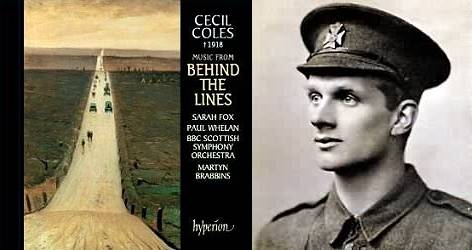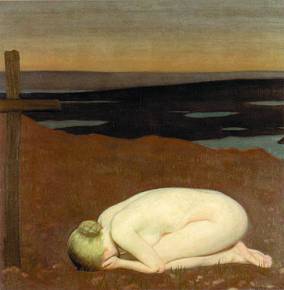|
<< -- 9 -- Roderic Dunnett BEHIND THE LINES

One other composer who fought in the trenches, a Scot (with a German
middle name, Gottlieb) was Cecil Coles (1888-1918). Coles was an exact contemporary
of Butterworth and a close friend of Holst (like Dvorák and Janácek,
the two went on hill walking holidays together). He was killed in the last
year of the war as a consequence of fresh German advances while serving
as a sergeant in France with the Ninth London Regiment (Queen Victoria Rifles).
A wide collection of Coles's music, which included several orchestral song
settings (some has been published by Bardic Music) including the Verlaine cycle Behind the
Lines and the semi-operatic scena Fra Giocomo, a setting of an
ultimately tragic Boccaccio-like tale (breathing the spirit of Schreker
and Puccini) by R W Buchanan, can be heard on another pioneering Hyperion
disc, Music from behind the lines (CDA 67293), which includes several orchestral song cycles.
Jeremy Dibble's valuable sleevenote can be found on the Hyperion website.

The 'Behind the Lines' Hyperion CD cover, and the music's composer, Cecil Coles
|
Coles studied in Stuttgart, where his overture The Comedy of Errors
(Die Komödie der Irrungen), composed there in 1911, was first
performed (it was repeated at the Cologne Conservatoire in June 1913). Before
the war he was appointed an assistant conductor at the Wurttemburgisches
Staatstheater (the Royal Opera House in Stuttgart, where Weber was once
Court Secretary and Hummel Court Kapellmeister). Max von Schillings, composer
of Mona Lisa (staged there in 1915), was Stuttgart's opera director
from 1908-18, coinciding with Coles's time there.

C R W Nevinson's 'The Doctor'. Photo: The Imperial War Museum, London
|
War painters, who are well represented in the Imperial War Museum exhibition,
help to bring the terrible events even closer home : among the most striking
are C R W Nevinson's Cubist-inspired The Doctor and Henry Tonks's
searing Four Studies of Facial Wounds, 1916, their gashes like a
harbinger of Francis Bacon. Here too are Nash, Rogers, Kennington; and Sir
George Clausen's 'Youth' 1916, a wan pre-Raphaelite female
figure who somehow encapsulates the universal and overriding sense of loss.

Sir George Clausen's 'Youth Mourning'. Photo: The Imperial War Museum, London
|
David Jones, Eliot-influenced and one of the most enduring of these poets,
was (as mentioned) an artist as well : sketches by him (including one of
Edward, Prince of Wales, and a more potent Pilate Washing his Hands,
with shades of Eric Gill and the German Expressionists) each strike a nerve.
Indeed, one of the most striking pictures in the whole exhibition is
a sketch of Jones by Joy Finzi, wife of Farrar's pupil, Gerald Finzi -- a
composer deeply affected by the losses of the First World War. It was to
Finzi above all, together with his friend Howard Ferguson and fellow-composer
Michael Hurd, Gurney's biographer (Hurd's magnificent and unsurpassed biographical
portrait, The Ordeal of Ivor Gurney, originally published by OUP
and now frustratingly out of print, is shortly to be reissued by the Carcanet
Press), that we owe the rediscovery and due recognition given to Gurney's
songs around the time of his death, and subsequently.
Continue >>
Copyright © 26 December 2002
Roderic Dunnett, Malvern, Worcestershire, UK

|

